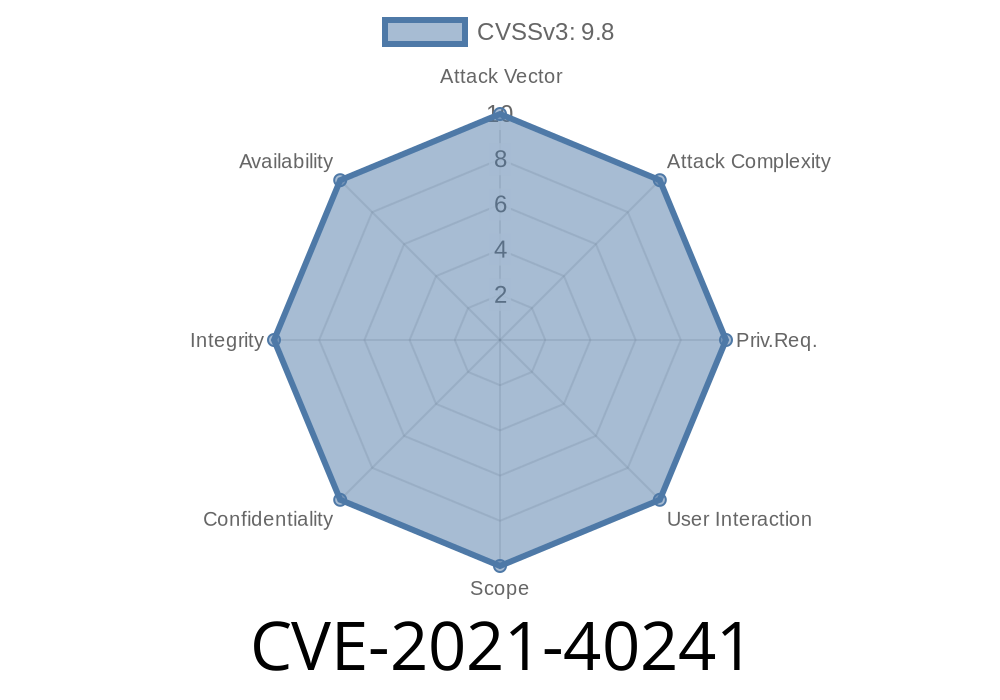xfig, a widely-used diagramming tool for Unix/Linux platforms, has a dangerous buffer overflow vulnerability in version 3.2.7 that could lead to arbitrary code execution on the victim's system. A remote attacker could exploit this vulnerability by targeting the LoadFIG function to corrupt memory and execute malicious code.
This blog post will analyze the vulnerability, provide a code snippet from the vulnerable source code, and explain how the vulnerability can be exploited. We'll also provide links to original references and external resources for more details.
2. The Vulnerability: CVE-2021-40241
The Common Vulnerabilities and Exposures (CVE) identifier for this vulnerability is CVE-2021-40241. The vulnerability has a CVSS (Common Vulnerability Scoring System) score of 9.8 out of 10, indicating that it poses a critical threat to users.
2.1 Description
The vulnerability resides in the handling of FIG files in xfig 3.2.7. When parsing a specially crafted FIG file, a buffer overflow occurs while decoding the Color_Change command. Attackers can exploit this vulnerability by crafting a malicious FIG file that overflows the buffer[] array. This manipulation can lead to corruption of the program's memory, potentially allowing arbitrary code execution.
The following code snippet from the LoadFIG function highlights the vulnerable component
#define MAX_COLOR_NAME_CHARS 128
...
static void load_color_changes(void)
{
char buffer[MAX_COLOR_NAME_CHARS];
...
while (fgets(buffer, sizeof(buffer), file)) {
if (sscanf(buffer, "%*d %*d %*s ...") <= )
break;
str_pos = strrchr(buffer, '\n');
if (str_pos != BUFFER_NULL)
*str_pos = '\';
Color_Change(&buffer);
}
}
Here, the buffer[] array is declared with a fixed size of MAX_COLOR_NAME_CHARS (128 bytes). However, the fgets() function in the while loop reads data from a file into buffer[] without any validation or bounds checking. This can lead to a buffer overflow if an attacker crafts a file with a line longer than the buffer size.
The exploitation of this vulnerability involves the following steps
1. Create a malicious FIG file containing a long line exceeding the buffer size in the Color_Change command.
Entice the victim to open the malicious FIG file in xfig 3.2.7.
3. The buffer overflow occurs in the LoadFIG function, corrupting memory and potentially leading to arbitrary code execution.
3. References and Additional Resources
- The original vulnerability report: xfig - a tool for drawing graphics in X Window System - buffer overflow
- Further analysis of the vulnerability: xfig Buffer Overflow Vulnerability Analysis
- Official xfig website: xfig.org
- xfig source code: xfig on SourceForge
- CVE-2021-40241 on the National Vulnerability Database: CVE-2021-40241
4. Conclusion
The buffer overflow vulnerability in xfig 3.2.7 (CVE-2021-40241) is a serious security risk. It is essential for users to update to the latest version of xfig to protect themselves from potential attacks. Additionally, exercising caution when opening FIG files from untrusted sources can help mitigate the risk of exploitation.
Timeline
Published on: 10/31/2022 16:15:00 UTC
Last modified on: 11/01/2022 14:08:00 UTC
